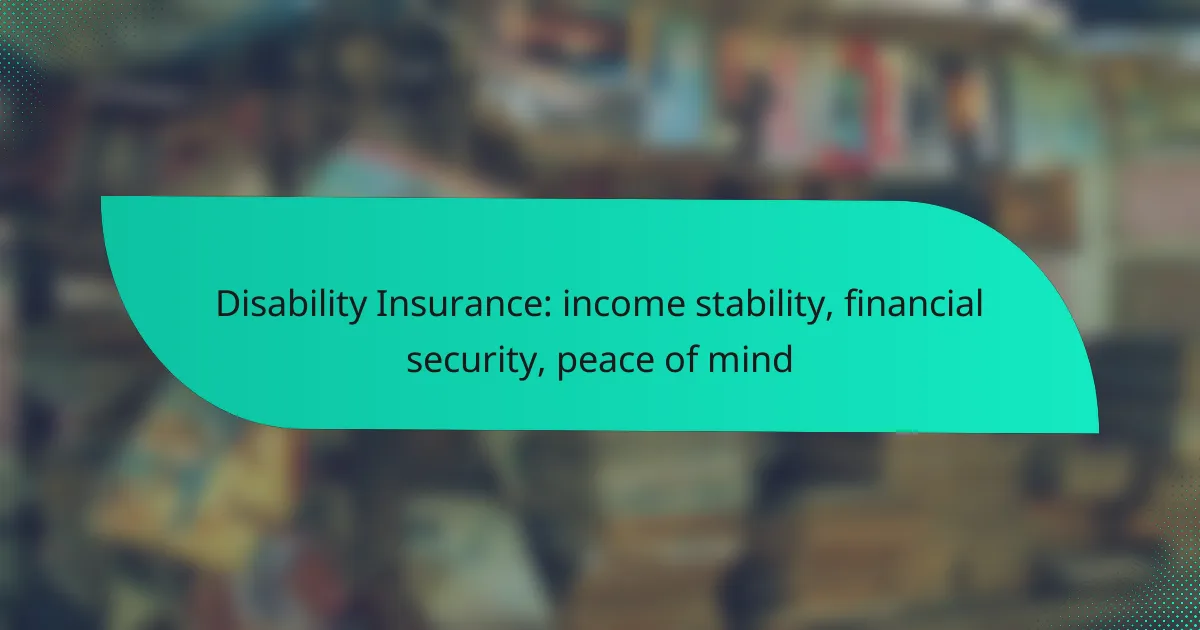Disability insurance is a crucial financial tool that offers income stability by replacing a portion of your earnings when you are unable to work due to illness or injury. This coverage not only helps maintain your standard of living but also provides peace of mind, allowing you to focus on recovery without the worry of financial hardship.

How does disability insurance provide income stability?
Disability insurance offers income stability by replacing a portion of your lost earnings when you cannot work due to illness or injury. This financial support helps maintain your standard of living and covers essential expenses during challenging times.
Monthly benefit payments
Monthly benefit payments from disability insurance typically replace a percentage of your income, often ranging from 50% to 70%. These payments are designed to help you manage your regular expenses, such as mortgage or rent, utilities, and groceries. Understanding the terms of your policy is crucial, as some plans may have waiting periods before benefits begin.
Coverage for long-term disabilities
Disability insurance can provide coverage for long-term disabilities, which may last for several months or even years. Policies often differentiate between short-term and long-term coverage, with long-term plans generally offering benefits for several years or until retirement age. Evaluating the duration of coverage is essential when selecting a policy to ensure it meets your needs.
Protection against job loss
Disability insurance protects against job loss due to unforeseen health issues, allowing you to focus on recovery rather than financial stress. This type of insurance can be especially valuable in industries with high physical demands or for individuals in high-risk occupations. It’s important to review your policy for specific exclusions and limitations related to job loss and disability claims.

What are the financial security benefits of disability insurance?
Disability insurance provides financial security by replacing a portion of your income if you become unable to work due to illness or injury. This coverage helps maintain your standard of living, ensuring you can meet essential expenses and avoid financial hardship.
Debt repayment assistance
Disability insurance can assist in managing debt repayments during periods of lost income. When you are unable to work, your policy may cover a significant percentage of your salary, allowing you to continue making payments on loans, credit cards, and mortgages.
For example, if your monthly debt obligations total $1,500 and your disability insurance replaces 60% of your income, you could receive around $2,000 monthly, providing a buffer for your financial commitments.
Retirement savings protection
Maintaining contributions to retirement savings is crucial, even when facing disability. Many disability insurance policies include provisions that allow for continued contributions to retirement accounts, helping to protect your long-term financial security.
Consider a policy that not only covers your current expenses but also includes a benefit for retirement savings. This ensures that your future financial stability is not compromised during your recovery period.
Family financial support
Disability insurance plays a vital role in providing financial support for your family if you are unable to work. The income replacement can help cover household expenses, childcare, and education costs, ensuring your family’s needs are met.
For instance, if your family relies on your income for daily living expenses, a disability policy that replaces 70% of your salary can significantly ease the financial burden, allowing your family to maintain their lifestyle during your recovery.

How does disability insurance contribute to peace of mind?
Disability insurance provides peace of mind by ensuring a steady income during periods of illness or injury that prevent work. This financial safety net allows individuals to focus on recovery without the added stress of financial instability.
Reduced financial stress
Disability insurance significantly reduces financial stress by replacing a portion of lost income when a person cannot work due to a disability. Typically, policies cover around 60-80% of your pre-disability earnings, which can help maintain your standard of living.
Without this coverage, individuals may face difficulties in meeting monthly expenses, such as rent or mortgage payments, utilities, and groceries. Having a reliable income source alleviates these pressures and allows for better focus on health and recovery.
Security for dependents
For those with dependents, disability insurance offers crucial security by ensuring that family members are financially supported in case of an unexpected disability. This coverage helps maintain household stability, allowing dependents to continue their education or meet other essential needs.
In the absence of such insurance, families might struggle to cover basic living costs, leading to potential hardships. Policies can be tailored to provide sufficient coverage based on family size and financial obligations, ensuring dependents are protected.
Access to mental health resources
Many disability insurance plans include access to mental health resources, which can be vital during challenging times. This access can encompass therapy sessions, counseling, and support groups, which help individuals cope with the emotional impact of their situation.
Utilizing these resources can enhance overall well-being, making it easier to navigate the recovery process. It is advisable to review your policy to understand the mental health benefits available and how to access them effectively.

What factors should you consider when choosing a disability insurance policy?
When selecting a disability insurance policy, consider the coverage amount, policy terms, premium costs, and waiting periods. These factors significantly impact your financial security and peace of mind in case of a disability.
Policy terms and conditions
Understanding the policy terms and conditions is crucial as they define what is covered and under what circumstances. Look for specifics on the definition of disability, the duration of benefits, and any exclusions that may apply.
For instance, some policies may only cover total disabilities, while others might include partial disabilities. Ensure you know how long benefits will last—some policies provide coverage until retirement age, while others may have shorter terms.
Premium costs
Premium costs vary widely based on factors such as age, health, occupation, and the level of coverage chosen. Generally, policies can range from a few tens to several hundreds of dollars per month.
It’s essential to balance premium costs with the benefits provided. A lower premium may seem attractive, but it could come with reduced coverage or higher deductibles, which may not provide adequate financial support when needed.
Waiting periods
The waiting period, or elimination period, is the time you must wait after becoming disabled before benefits begin. This period can range from a few weeks to several months, and it directly affects your financial planning.
Choosing a shorter waiting period typically results in higher premiums. Consider your savings and other income sources to determine how long you can afford to wait for benefits to start. A common approach is to select a waiting period that aligns with your financial reserves to ensure stability during that time.

How do state regulations impact disability insurance in the United States?
State regulations significantly influence disability insurance by determining coverage mandates, benefit structures, and eligibility criteria. Each state has its own laws that can affect how policies are written and what benefits are available to residents.
State-specific coverage requirements
Coverage requirements for disability insurance vary by state, with some mandating specific benefits or minimum coverage levels. For example, California requires employers to provide short-term disability insurance, while other states may not have such mandates.
It’s essential for individuals to understand their state’s specific requirements to ensure they have adequate protection. Checking with local insurance regulators or consulting with an insurance agent can provide clarity on what is necessary in your state.
Variations in benefits
Benefits provided by disability insurance can differ significantly across states, affecting the amount and duration of payments. Some states offer more generous benefits, while others may have stricter limits on payout amounts and the length of time benefits are available.
For instance, in New York, disability benefits can cover up to 50% of an employee’s average weekly wage, capped at a certain amount. Understanding these variations is crucial for selecting the right policy and ensuring financial stability in case of a disability.
